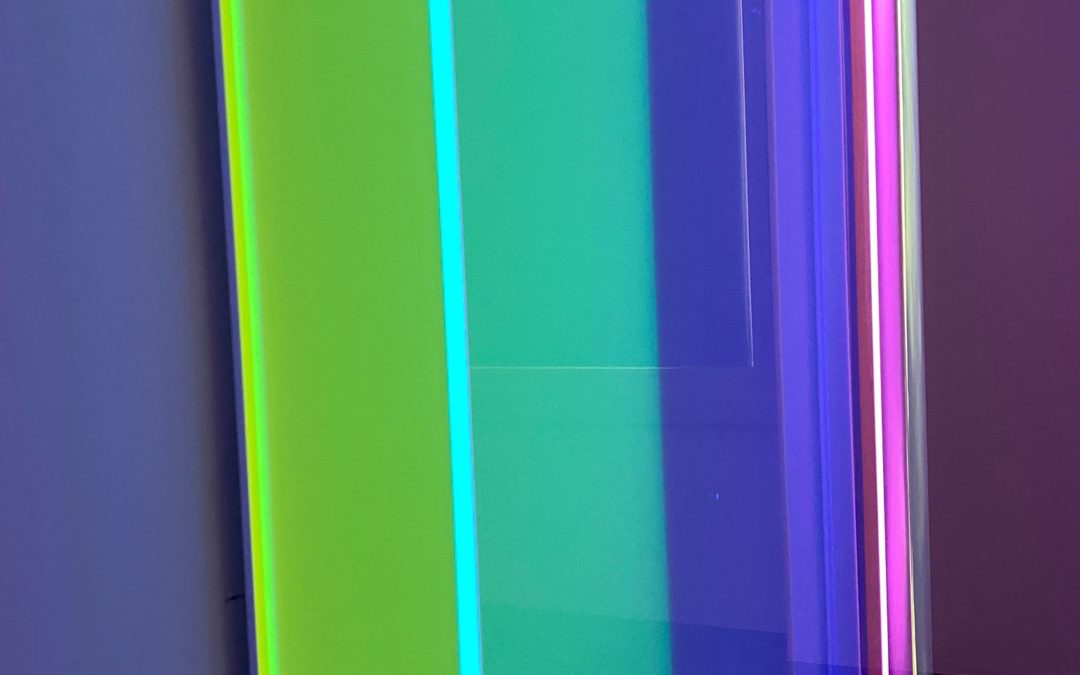The art gallery as a family: Dep Art’s vision about the future
On the February 11th, the SpeakArt’s team was in Milan.
We had the opportunity to interview Dott. Antonio Addamiano, founder and director of Dep Art Gallery,one of the most renowned galleries in the national and international art scene. It was an informative and interesting afternoon during which we talked all-round art.
At the core of the meeting there was the phenomenon of the arts’ digitalization, wich is increasingly necessary and imminent, together with the need to educate and guide collectors and artists in that direction, especially the younger ones, to take small steps forward into the transformation of a traditionally opaque market into a more transparent one.
Mr. Addamiano also explained us how his gallery has managed the Covid emergency since the first pandemic wave and how he and his team have faced – let’s add successfully – such a difficult period.
His main strength, as he has already confirmed, is given by the sense of family and intimacy that Dep Art has been able to build over the years.
Last, but certainly not least, the reference to the solo exhibition of Regine Schumann hosted in this period by the gallery which is also one of the protagonists of Viavai, a great cultural initiative in Via della Spiga in Milan.
We thanks again Dr. Addamiano and Dep Art’s team for their availability and courtesy. Here follows the full interview.
SpeakART:Dep Art is one of the most successful galleries within the Italian and international artistic scene. In the year of the pandemic, you were among the very few to have done a substantial digital investment, prior to Covid, thanks to which you were already present on the main digital platforms (Artnet, Ocula, Artsy, Pinterest), and you were far-sighted in strengthening your presence on Linkedin and Youtube. Is this still a winning choice today?
A.A: We can say that yes, it is still a winning choice. Surely the two platforms that we continued to follow right from the beginning were Facebook and Instagram, on which we have been active for six years and, over the years, we have adopted a strategic growth with some ad hoc sponsorships. In any case, at the very bottom there are valuable contents with artists of strong impact and highly requested by the market as nowadays is Salvo (pseudonym of Salvatore Mangione) or internationally renewed artists such as Wolfram Ulrivh and Regien Schumann, that have currently exhibitions in Brasil and Japan.
About all the other digital platforms, I think myself as an experimenter: I am one of the first to have landed on Artprice – since 2007- , as well as on Artsy and Artnet which I use both professionally and for personal reasons. Over time, I was able to try different portals and understand the potential of each one. The last social network with which I positively interfaced was Pinterest: I rearranged the many photos I had since 2004 and which tell what I have seen in life in recent years, starting from arrival of Kiefer in Milan at Hangar Bicocca and so on. These photos also give a more intimate look at the gallery and our curiosities related to our travels. Then fate wanted the collaboration with design to also be born after so many requests from companies of various types, Cassina’s proposal arrived and even those images were included on Pinterest; I must confess that it is the folder focused on design that is the most successful. Lately, we have also started to arrange the book section thanks to the help of an external collaborator who is in charge of the management and sale of the volumes. Dep Art Gallery, indeed, is present both in online bookstores and in art fairs.
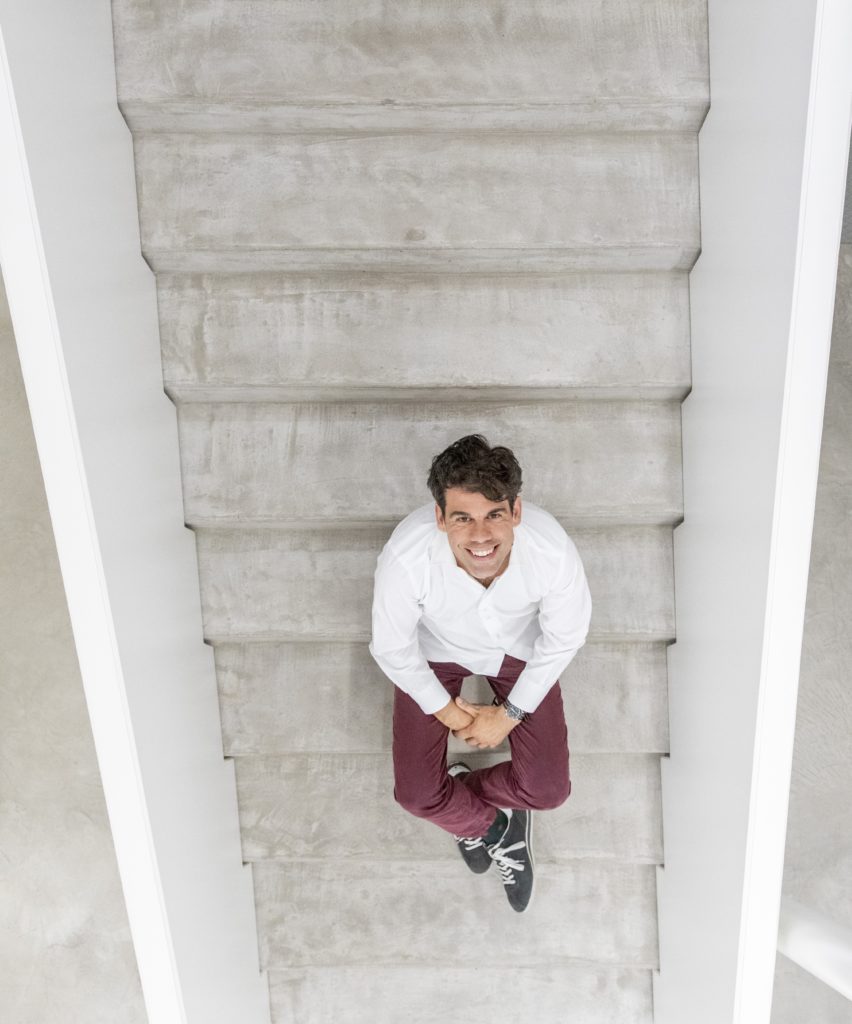
Antonio Addamiano, founder and director of Dep Art Gallery – Courtesy of Dep Art
SpeakART: Without any doubt you’ve achieved an incredible success, but can you tell us what attempts, if there have been any, that did not bring the hoped results?
A.A:The less successful experiments are Widewalls and Ocula. However, we are still pleased to stay on it because of its high profile and contained cost. On the opposite, ArsValue closed with the galleries and focused on auction houses. By far, Artsy is the best but currently Artnet is doing better, we are closing deals more often there.
It must also be admitted that not all the galleries want to be part of these platforms because they are less likely to share their customers, risking to compete with others for price or sale. When you are on these websites, you are all the same and obviously for the larger galleries it could be a damage because the vision of the works is the same for all the operators and the different professional levels are not always perceived.
SpeakART:Dep Art is synonymous with innovation and experimentation, what are the projects in this sense?
A.A: That’s right, the gallery is always open to new experiments. Just in these days we will host one of XFactor’s partecipant who, fell in love with the gallery’s spaces and the lights of Regine Schumann works, decided to do a photoshoot here for the release of her album. A huge part of the credit certainly goes to Regine that always attracts a new target of audience. In this regard, a Chinese influencer also came to the gallery some time ago and, impressed by the gallery, posted images on Instagram. You can imagine the media response. All this does not turn into sales but into visibility. Never take any opportunity for granted or underestimate it. Curiosity is the key, it is right to understand what is behind any chance.
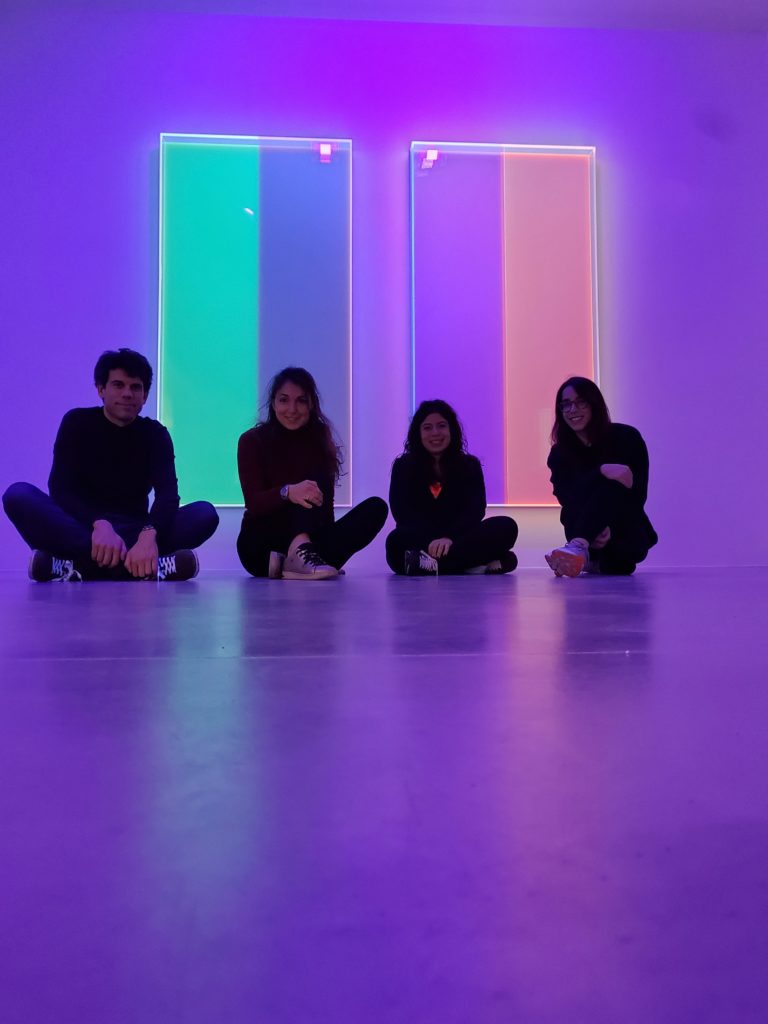
Dep Art team during the set up of Regine Schumann Exhibition – Courtesy of Dep Art
SpeakART: Let’s talk about the public. Have you noticed any changes in the engagement’s level on these same platforms between the first pandemic wave (March – June) and the months ahead? Or, despite the decline in infections, have you remained faithful to the digital, confirming the same numbers?
A.A: About the public and its engagement, compared to the first pandemic wave, there has been a decline but we have been far-sighted in creating original contents and putting online the exhibition “The gesture of the East. Five voices of the avant-garde. Korean”. During the second lockdown, we worked on the materials of the previous months, carrying out four interviews with the four living artists we have in the gallery (Turi Simeti, Alberto Biasi, Pino Pinelli and Natale Addamiano) and with the help of a video maker, reviewing all the recordings gathered during the summer collective, we were able to put together new video contents which, for instance, not only gave a deeper analysis of the artist’s vision but also the “life” of the artworks, their exhibition history and the dialogue they establish with the space where they are placed. This is the case of Pino Pinelli, from there we understood that maybe people, staying more at home, needed something new. What? The interviews shaped on their protagonists: Simeti’s is biographical, there we communicate his character (all subtitled in English) while those of Addamiano, Pinelli and Biasi were on a single theme in order to intrigue the viewer and , if they were successful, we would then launched a second edition with another theme. During the interviews, we gradually understood what was needed to be improved. From the one about Simeti which, also in terms of content, was simpler than the other “double-shot” ones enriched with photographs. They are definitely more complex. It’s about experience: there is no one who teaches you how to do it, even the staff has learned in this way how to produce the contents and understand what could work and what didn’t. Now we have got that Biasi’s format is the right one and in the next edition, with Regine Schumann, we already know which direction take, speeding up the whole process. The art world is a niche, so you can’t call someone who knows how to conduct an interview, except for the industry giants such as David Zwirner or Gagosian Thaddaeus Ropac. In Italy there aren’t specialized realities that support art in this sense, especially in this moment of emergency with Covid. In the end, this experiment went so well that, when it came to wishing our customers new year’s greetings with the newsletter, we sent out the four interviews.
We were also contacted by ArtsLife that, delighted by the success and the idea, offered us to share the interviews on their TV channel: ArtsLife TV.
All the interview contents then went onto Youtube and we inevitably got more contacts.It is certainly something that was born by chance but that will become part of the budget for every exhibition to come.
SpeakART: Staying on the pandemic theme, in the last year we have lost the possibility of having physical contact with people. A fundamental aspect has been lacking, especially within the Italian market, which is based on building “physical” relationships with people. Looking at its history, Dep Art has always been committed to creating a familiar and intimate atmosphere in the gallery. When it will be possible, what will be the steps to return to that condition? Is art strong enough to act as a glue and bring people together?
A.A:This is the goal. Our gallery’s artists are fond of us and vice versa, we have built a long lasting relationship with them as well as with our other collaborators. For instance, we have been working with the same curators, graphic designers and photographers for years. Still talking about family, just last week I bought a small property in Puglia, overall a trullo and a small farm, to build an artist’s residence.
The idea is to build a maximum of six or seven rooms and host the artists together with other people. An initiative of this kind, especially if proposed to foreigners, is very popular: the trullo for example, has an indisputable charm that always attracts. We will try to recreate a familiar environment there too. I care a lot about this project, because I believe it can be an opportunity to create network and new connections, also because it is the homeland of my family.
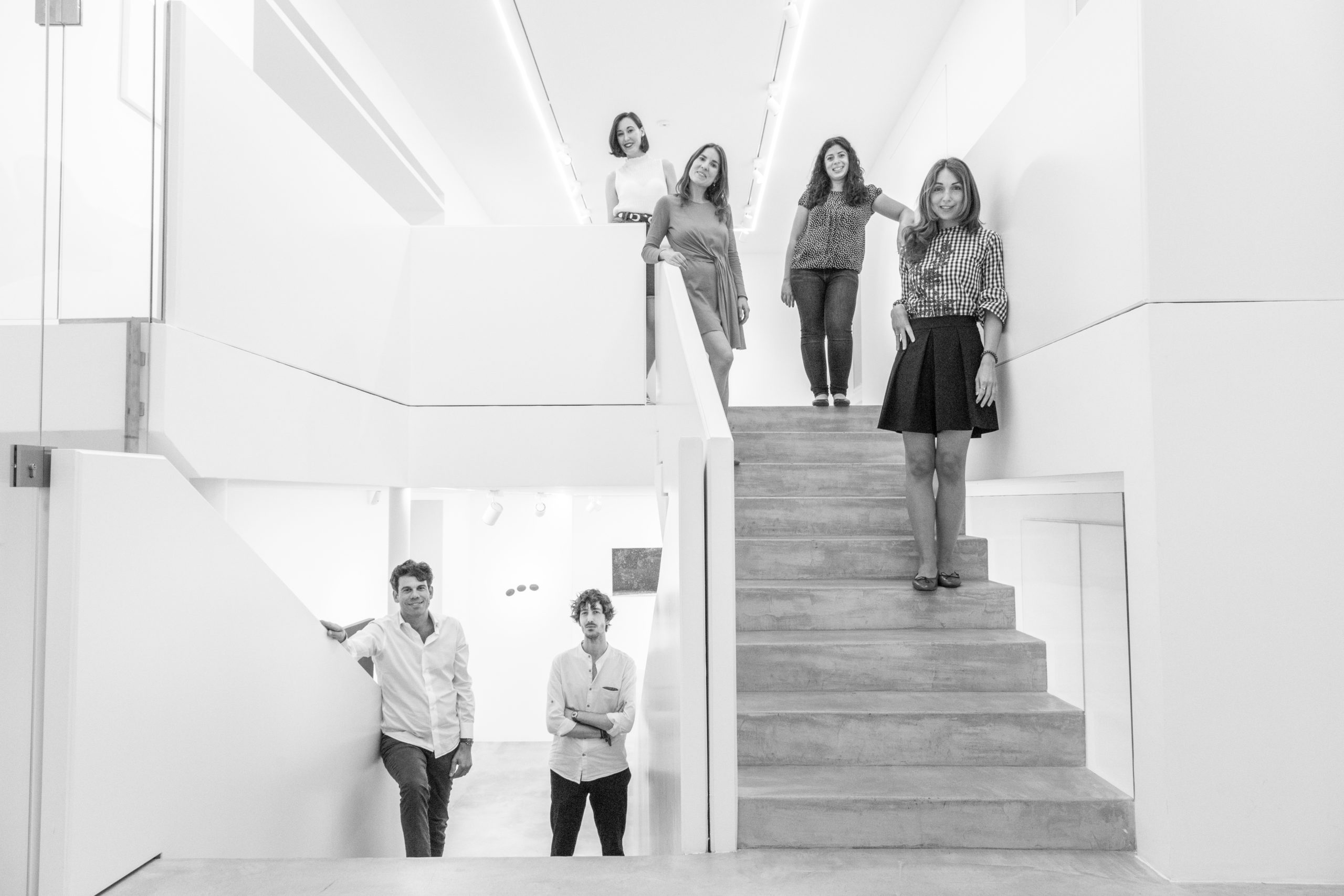
Thw Dep Art Gallery team – Courtesy of Dep Art Gallery
SpeakART:Unity is strength. You are the regional representative for Lombardy within the ANGAMC, which is the community par excellence and is also synonymous with support as it promotes the development of a real galleries’ association. The new Market function on the Angamc website was born from this desire for cohesion. However, teh majority of galleries remain a predominantly private sector and are not exactly known for their collaborative spirit. Can you explain better what Market is? Could you tell us how DepArt has established itself as a counter-trend model of this mindset?
A.A: Yes, we realized that around half of the paintings in the auctions were paintings given by gallery owners:
a little due to a lack of knowledge, a little due to a lack of time, the gallery owners are used to give their artworks to auction houses but when feeding the latter too much, our sector is inevitably damaged. This year, the auctions have made a huge turnover, even the smallest one has reached approximately five million income.
Therefore, we have developed the idea of Market and we developed its communication. It is a hidden platform in which dozens of paintings are uploaded and the users, all galleries’ owners, can see them from the inside. In this way we have also overcome the issues related to images’ rights owned by SIAE’s authors. To be honest, however, common sense is lacking: ANGAMC’s memebers should be more involved but many of them, just to give an example, do not even insert the association’s logo in their exhibitions or events. The main problem is the lack of collaboration. In my opinion, I have always thought that would be helpful to have a manager to handle the activities and initiatives of Angamc because are things that cannot be delegated to gallerists who are already too busy on other fronts. Unfortunately the regulation prohibits the management of those who are not galleries’ owners. Obviously, that’s just my opinion. The work of the council is unpaid, we also pay the membership fee.
SpeakART:Digitalizing art is a need, as confirmed by the fairs of the last year. Evenmore, the cataloging of artworks in a gallery is a key point for improving the services and transparency of a market that has always been considered opaque. Are progress being made in this direction?
A.A: We are certainly committed on this front: we have always issued an invoice with details of the work and with photography, somewhat copying the system that at the beginning of the 2000s had already been put into practice by important foreign galleries and by Sotheby’s. A tax document of this kind, in fact, is accompanied by a photo and description has greater value in a future sale than a common certificate without a photo.
SpeakART: DepArt is also the headquarter of Turi Simeti’s archive, the gallery’s key artist. To ease the archiving process, you have also included a digital format to fill out. Do you think that collectors respond well to this system update?
A.A: Yes, collectors respond well too. Taking up, for example, the discourse of high-resolution photos for the archives, it is already three or four years that many collectors after the purchase of the work also requested professional archival photos to catalog their works, even if this is more recurrent in the case of inheritance or Foundations as there is a need to check the authentications in possession.
Archiving is a document that is required in any sale of works of art, in compliance with current regulations.
In my case, for example, it is necessary to take into account the fact that Simeti first personally issued authentic for forty years, then moving on to use the paid service of certification and publication of Artantide (Verona) for about ten years – and finally, since December 2013 we have created the Turi Simeti archive, for free , with the aim of enhancing the artist, his artistic production and the production of the catalog raisonné published by Skira in 2017. The case just described is an example of how documents have evolved along with the artist’s career and with technologies. With one artist, there are three different cases of issuing authentications, improving the management of the archive over time.
SpeakART: Given the current situation, talking about future goals is difficult and it’s definitely better keeping the feet on the ground. Many projects scheduled last year have been postponed, just think of the fairs. In any case, among your fair declared objectives, we know there are three fairs: Art Brussels, Art Cologne, and Expo Chicago. How is Dep Art preparing? Is the post-Covid foreign market scary?
A.A: Exactly, we want to concentrate well on the projects that have unfortunately remained stationary in 2020 such as Art Brussels, Art Cologne and Expo Chicago, where we have decided to present ourselves with personal exhibitions in all three cases because we believe it gives us more character and visual strength.
Also at Artissima in 2020 we had only one show planned dedicated to Mario Nigro, but with Covid the “physical” fair has turned into an important collaboration with the most prestigious institutions in the city thanks to an excellent idea and organization. Even the fairs, in my opinion, being a strongly affected sector, need to come back with more special and attractive projects. As for all the fairs not yet booked or organized, let’s be more cautious waiting to see how the situation will evolve: those who participate, how the public will react, how it will be possible to attract future collectors and perhaps bring the Asian market closer. Fairs are significant economic investments and must be approached calmly by starting over, at least in my opinion, from a prudent approach without getting into debt and choosing well the most suitable events for your own gallery. Small young galleries will be even more careful in their choice.
SpeakART: From future goals, let’s move to those already achieved: “Viavai” in Via della Spiga in Milan with Regine Shumann. Dep Art hosts from February 2 until March 30 the solo exhibition of the artist, who has always been considered the painter of light. Adopting this metaphor, is this an initiative that brings a little light in a city devastated by Covid?
A.A: In November, some shopkeepers in Via della Spiga, in possession of five free spaces due to the pandemic, decided to make a cultural investment for the relaunch of the prestigious Via in the city of Milano. The choice of Federica Sala, an important curator of contemporary art who not only selected five artists, including Regine Schumann, but also took care of the set-up and public relations.
We as a gallery supported the set-up and transport costs.
It is a pleasure to participate in this initiative, which involves my city in a difficult moment, and we feel lucky because Regine Schumann, an artist whose solo exhibition we have in the gallery, was chosen.
Another luck, out of curiosity, when it came to choosing the shop, I deliberately chose the most essential, capable of bringing out the beauty of the German artist’s works in contrast with the “emptiness” of the environment. Thanks to the glossy black flooring and the presence of mirrors, the result is incredible.
The journalists and the media were enthusiastic and it is certainly a help to the city of Milan, it is the strong gesture of a private individual who has decided to finance culture.
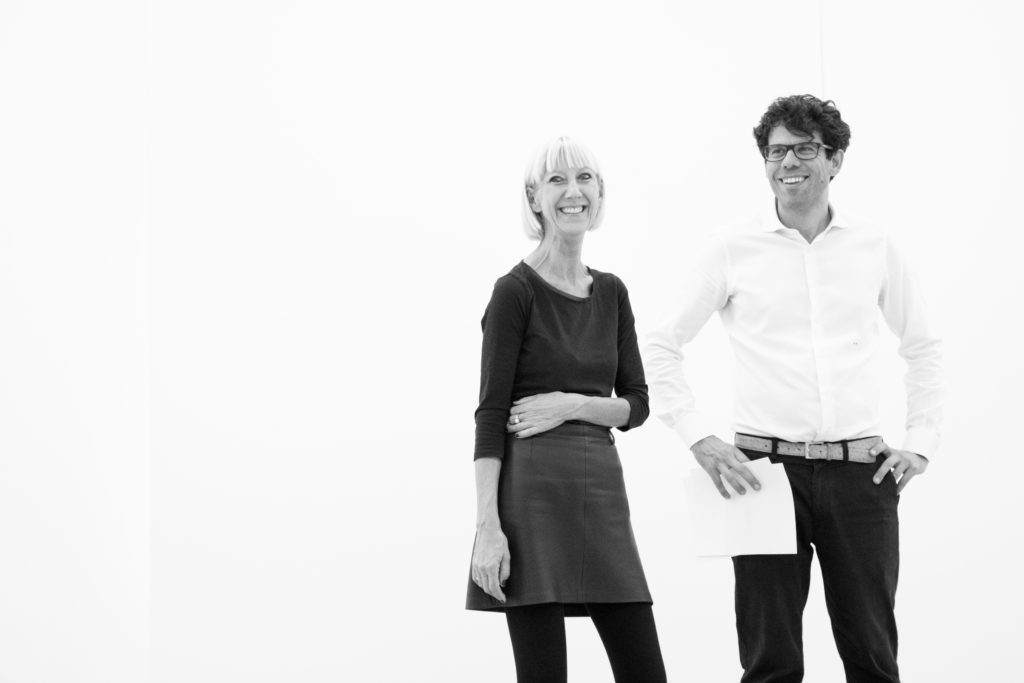
Antonio Addamiano with artist Regine Shumann – Courtesy of Dep Art
SpeakART: Given your attention to the world of digital and innovation, to what extent do you believe that technology, not intended as a simple cataloging of works of art, is effective in the world of art?
A.A: I am thinking, for istance, of young artists, who can exploit technology to organize and immediately protect their works. This, together with the invoices of the works sold, can allow the creation of digital archives that protects the work even in the following years.
Being “technologically and digitally organized” also means being ready for any request. Whether it’s an exhibition abroad or the production of a document for a museum or foundation.
